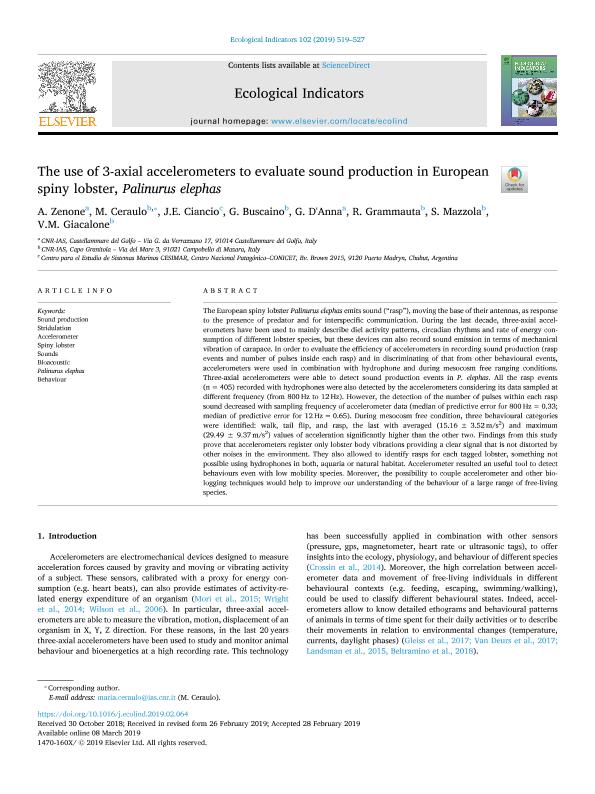Artículo
The use of 3-axial accelerometers to evaluate sound production in European spiny lobster, Palinurus elephas
Zenone, Arturo; Ceraulo, Maria; Ciancio Blanc, Javier Ernesto ; Buscaino, Giuseppa; D'Anna, Giovanni; Grammauta, Rosario; Mazzola, Salvatore; Giacalone, Vincenzo Maximiliano
; Buscaino, Giuseppa; D'Anna, Giovanni; Grammauta, Rosario; Mazzola, Salvatore; Giacalone, Vincenzo Maximiliano
 ; Buscaino, Giuseppa; D'Anna, Giovanni; Grammauta, Rosario; Mazzola, Salvatore; Giacalone, Vincenzo Maximiliano
; Buscaino, Giuseppa; D'Anna, Giovanni; Grammauta, Rosario; Mazzola, Salvatore; Giacalone, Vincenzo Maximiliano
Fecha de publicación:
07/2019
Editorial:
Elsevier Science
Revista:
Ecological Indicators
ISSN:
1470-160X
Idioma:
Inglés
Tipo de recurso:
Artículo publicado
Clasificación temática:
Resumen
The European spiny lobster Palinurus elephas emits sound (“rasp”), moving the base of their antennas, as response to the presence of predator and for interspecific communication. During the last decade, three-axial accelerometers have been used to mainly describe diel activity patterns, circadian rhythms and rate of energy consumption of different lobster species, but these devices can also record sound emission in terms of mechanical vibration of carapace. In order to evaluate the efficiency of accelerometers in recording sound production (rasp events and number of pulses inside each rasp) and in discriminating of that from other behavioural events, accelerometers were used in combination with hydrophone and during mesocosm free ranging conditions. Three-axial accelerometers were able to detect sound production events in P. elephas. All the rasp events (n = 405) recorded with hydrophones were also detected by the accelerometers considering its data sampled at different frequency (from 800 Hz to 12 Hz). However, the detection of the number of pulses within each rasp sound decreased with sampling frequency of accelerometer data (median of predictive error for 800 Hz = 0.33; median of predictive error for 12 Hz = 0.65). During mesocosm free condition, three behavioural categories were identified: walk, tail flip, and rasp, the last with averaged (15.16 ± 3.52 m/s2 ) and maximum (29.49 ± 9.37 m/s2 ) values of acceleration significantly higher than the other two. Findings from this study prove that accelerometers register only lobster body vibrations providing a clear signal that is not distorted by other noises in the environment. They also allowed to identify rasps for each tagged lobster, something not possible using hydrophones in both, aquaria or natural habitat. Accelerometer resulted an useful tool to detect behaviours even with low mobility species. Moreover, the possibility to couple accelerometer and other biologging techniques would help to improve our understanding of the behaviour of a large range of free-living species.
Archivos asociados
Licencia
Identificadores
Colecciones
Articulos(CESIMAR)
Articulos de CENTRO PARA EL ESTUDIO DE SISTEMAS MARINOS
Articulos de CENTRO PARA EL ESTUDIO DE SISTEMAS MARINOS
Citación
Zenone, Arturo; Ceraulo, Maria; Ciancio Blanc, Javier Ernesto; Buscaino, Giuseppa; D'Anna, Giovanni; et al.; The use of 3-axial accelerometers to evaluate sound production in European spiny lobster, Palinurus elephas; Elsevier Science; Ecological Indicators; 102; 7-2019; 519-527
Compartir
Altmétricas



